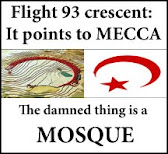Here is an outstanding article on the Crusades as a repsonse to Islamic aggression. I am going to let stand Baron Bodissey's introduction a s it is at Gates of Vienna.
________________________________________________________________________________________________________________________________________________________
The Crusades: A Response to Islamic Aggression
by Baron Bodissey
John J. O’Neill’s latest essay shines a light on the historical reality of the Crusades, which were a defensive action against the forcible expansion of Islam into territories that had been part of Christendom for centuries.
The Crusades: A Response to Islamic Aggression
by John J. O’Neill
One of the most potent myths of our age is that the Crusades were little more than an unprovoked attack by a barbarous Europe against a quiescent and cultured Islamic world. According to conventional ideas, the seventh and eighth centuries constitute the great age of Islamic expansion. By the eleventh century — the time of the First Crusade — we are told that the Islamic world was quiescent and settled and that, by implication, the Crusaders were the aggressors. Indeed, the Crusaders are routinely portrayed as a horde of barbarians from a backward and superstitious Europe irrupting into the cultured and urbane world of the eleventh century Near East.
This at least is the populist language often employed on television and in newspaper articles. In my recent book Holy Warriors: Islam and the Demise of Classical Civilization, I have shown however that before the advent of Islam Christians had no concept of “Holy War” at all, and that it was from the Muslims themselves that Europeans took this idea. I showed too that the Crusades, far from being an unprovoked act of aggression on the part of Christian Europe, was part of a rearguard action aimed at stemming the Muslim advance which, by the start of the eleventh century, was threatening as never before to overwhelm the whole of Europe.
Notwithstanding the evidence presented in Holy Warriors, the consensus among the majority of medieval historians is that the threat from Islam had very little, if anything, to do with the Crusades; the Muslims were simply the convenient targets of a savage and brutal Europe, mired in a culture of habitual violence and rapine. The “energies” of Europe’s warrior-class, it is held, were simply directed by the Papacy away from internal destruction onto the convenient targets of the Islamic world. This, for example, is the line taken by Marcus Bull in his examination of the origins of the Crusades in The Oxford History of the Crusades. In an article of almost ten thousand words, Bull fails to consider the Muslim threat at all. Indeed he mentions it only to dismiss it:
“The perspective of a Mediterranean-wide struggle [between Islam and Christianity] was visible only to those institutions, in particular the papacy, which had the intelligence networks, grasp of geography, and sense of long historical tradition to take a broad overview of Christendom and its threatened predicament, real or supposed. This is a point which needs to be emphasized because the terminology of the crusades is often applied inaccurately to all the occasions in the decades before 1095 when Christians and Muslims found themselves coming to blows. An idea which underpins the imprecise usage is that the First Crusade was the last in, and the culmination of, a series of wars in the eleventh century which had been crusading in character, effectively ‘trial runs’ which had introduced Europeans to the essential features of the crusade. This is an untenable view.”(Marcus Bull, “Origins,” in Jonathan Riley-Smith (ed..) The Oxford History of the Crusades, p. 19)
With what justification, we might ask, does Bull dissociate the earlier Christian-Muslim conflicts of the eleventh century in Spain, Sicily, and Anatolia from the First Crusade? The answer can hardly be described as convincing. “There is plenty of evidence,” he says, “to suggest that people regarded Pope Urban II’s crusade appeal of 1095-6 as something of a shock to the communal system: it was felt to be effective precisely because it was different from anything attempted before.” (Ibid) Of course it was different: the Pope had called a meeting of all the potentates and prelates of Europe to urge the assembly of a mighty force to march to Constantinople and eventually to retake the Holy Land. It was new because of its scale and its ambition. But to thus dismiss the connection with what went before in Spain and Sicily — and Anatolia — is ridiculous. Such a statement can only derive from a mindset which somehow has to see the Crusaders as the aggressors and to thereby detach them from the legitimate defensive wars which Christians had been fighting in Spain and throughout the Mediterranean in the decades immediately preceding 1095.
The fact is, in the twenty years before the First Crusade, Christendom had lost the whole of Anatolia, an area greater than France, and a region right on the doorstep of Europe. In 1050 the Seljuk leader Togrul Beg undertook Holy War against the Christians of Anatolia, who had thus far resisted the power of the Caliphs. We are told that 130,000 Christians died in the war, but that, upon Togrul Beg’s death in 1063 the Christians reasserted their independence and freedom. This was however to be of short duration, and no sooner had Togrul Beg’s nephew Alp Arslan been proclaimed Sultan than the war was renewed. In 1064 the old Armenian capital of Ani was destroyed; and the prince of Kars, the last independent Armenian ruler, “gladly handed over his lands to the [Byzantine] Emperor in return for estates in the Taurus mountains. Large numbers of Armenians accompanied him to his new home.” (Steven Runciman, The History of the Crusades Vol. 1 (Cambridge, 1951) p.61) Indeed, at this time, the entire Armenian nation was effectively transplanted hundreds of miles to the south and west. Continue reading
Gates of Vienna
Subscribe to:
Post Comments (Atom)





























0 Comments - Share Yours!:
Post a Comment